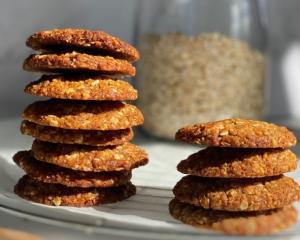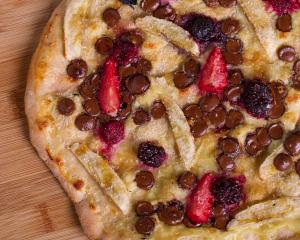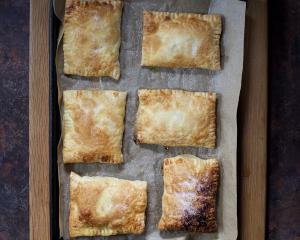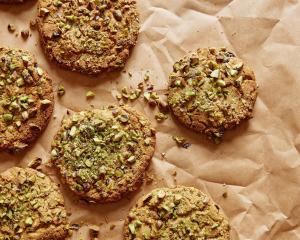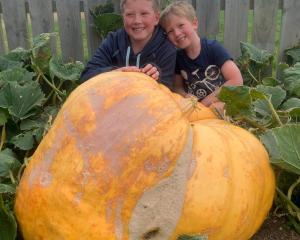It's about meat; his theme is that there should be no wastage from an animal and his recipes are for offal and unfashionable cuts as well as smarter ones.
Some are classic like veal blanquette, chicken liver pate, steak and kidney pie or Lancashire hotpot, while others are born of his experience working in New York, London, Los Angeles and Melbourne, such as marinated rabbit legs, crispy duck tongue salad or slow-roasted lamb shoulder with miso glaze and steamed aubergine.
They are complemented by Kieran Scott's photographs and Tamara West's styling, which evokes 17th century Flemish still-life paintings, depicting raw carcasses with wooden boards, pewter plates, herbs, vegetables and decanters of wine or oil.
The recipes are for cooks who enjoy exploring flavours and unusual ingredients like hearts, sweetbreads, quail and rabbit, as well as more common cuts of meat.
Not only do they keep pigs - there are photographs of cute, inquisitive pigs in their woodlot - but they explain how to cure, dry, smoke and ferment pork products from hams, bacon and pancetta to salamis and copa and recipes for various types of fresh sausages as well.
Recipes cover fresh pork, as well as ways to use sausages, ham and many other pork products.
Because it's nose-to-tail eating, there are recipes for snout and tail, heads, hearts, livers, kidneys, brains, ears, trotters and any other part of the pig you can think of.
They range from old favourites like toad in the hole, or roast loin of pork with crackling and apple sauce, through Vietnamese pho, devils on horseback and hotdogs, to scratchings, brain and avocado wrap, roasted, stuffed pig's head with pistachios, dates and parsley and even a bitter chocolate and orange dessert flavoured with olive oil and thickened with dried pig's blood.
A fascinating book for meat eaters and cooks who are not afraid to face where their meat comes from.
The innovative young chef introduces the reader to the tools and techniques of ''modernist cuisine'' which many chefs around the world have embraced.
These include the use of foams, gels, spheres, ''soils'' (dried and crumbled food), ingredients that look completely different from how they taste such as a mango sphere that looks just like a soft-cooked egg yolk, and unexpected combinations of flavours such as white chocolate and caviar, strawberry and coriander, salmon and liquorice and oysters and passionfruit, which are based on both ingredients containing some of the same flavour compounds.
Molecular gastronomy stems from a fascination with scientific techniques and the science and psychology of flavour and derives from the experiments of chefs like Heston Blumenthal at The Fat Duck in Britain and Ferron Adria at El Bulli in Spain, who investigated using laboratory equipment such as centrifuges, rotary evaporators and ultrasonics in their cooking.
They also worked with psychologists and neuroscientists on how we perceive flavour and qualities like freshness.
It turns out we use all our five senses, not just taste and smell.
One of the techniques, sous-vide- long slow, vacuum-packed cooking at a precise temperature in a waterbath - is used in a number of restaurants now, and you sometimes see foams and spheres decorating plates, but other techniques, such as using liquid nitrogen, anti-griddles (that instantly chill food) and the smoking gun (which exudes wood smoke) are less often seen here.
Some ancient food techniques are used too, such as dehydration and fermentation, but all in the service of multisensory flavour perception and presentation.
It's a book for avid cooks, chefs and other people who want to understand what's going on in leading restaurants around the world.
Artisan pizza: To make perfectly at home (Kyle Books) by Giuseppe Mascoli and Bridget Hugo of Franco Manca in London could be of interest.
It's full of many enticing recipes, but what I found interesting was their claim that most domestic ovens are not hot enough to heat a pizza stone to the required temperature and their suggestion to use a hot, cast-iron pan on top of the stove, then when the dough is firm, finish it under the grill.
Besides recipes from chefs at the Auckland Seafood School, it includes information on New Zealand fish species, fishing methods and how to store, handle and cook fish.
The recipes range from simple everyday ones like Italian-style cockles, grilled flounder, and bach-style pipi soup, to special occasion dishes like seared scallops with vanilla leek and pineapple melon salsa or poached seafood roulade, spinach and sauce vierge.
While fish from all round the country might converge on Auckland, it would have been helpful if the authors had mentioned where in the country each species was normally available.
From Victoria sponge and Madeira cake to Chinese moon cakes and Bath buns, from Marco Pierre White's Harvey's lemon tart and chocolate cinnamon babka to tarta de Santiago and feng li su (Taiwanese pineapple cake), there's a wealth of enticing, often traditional, recipes from around the world.
Interspersed are pages with information about famous bakeries and cafes and their cake specialties in cities around the world from London and New York to Paris, Vienna and Melbourne.
I look forward to some happy weekends baking from this book.
It's one of his best with tips and suggestions, as well as numerous inviting recipes.
They may not be as quick as those in his last book (15-minute meals) but they are flavoursome, hearty, wholesome, and inexpensive.
His charred veg salad, Singapore noodles, spiced beef tagine, superfast hungover noodles, or green sweet pea fish pie are all enticing and I plan to try his Portuguese fish stew at the weekend.
It's not all about desserts as you might expect, although there are several options for them.
Besides the pies, crumbles and fruit with cream or ice cream, there are salads that include fruit, herbs in fruit salads and fruit accompanying meat, pies, fish and vegetables.
Rhubarb fish parcels with soy and ginger, toad-in-the-hole with apples, rosehip and apple sorbet, banana in kedgeree, spiced chicken with dates and strawberry and peanut butter sandwich are just some of the adventurous recipes here.
No lists of instructions here.
On the opposite page are thoughts, tips and options.
''Fast'' in the title refers to the time it takes, less than an hour to cook these straightforward recipes.
Slater is one of my favourite food writers.
This is almost a sequel to his first book, Real fast food (1993), but our everyday eating has changed, a greater variety of ingredients is available and freshness is essential, we are more adventurous and our tastes have changed, hence the satisfaction of a new book.
It's going to be one of my favourites: the only problem is the binding and size don't allow it to lie flat.
It is lavishly illustrated, not only with photographs of food, but also of him and his three daughters joyfully cooking, eating and living the dream in Italy.
His recipes are in the style his followers have come to expect: relatively simple, fresh, summery and with a modern Italian flavour, if not entirely nonna's cooking.
A book for the coffee table or the kitchen.

